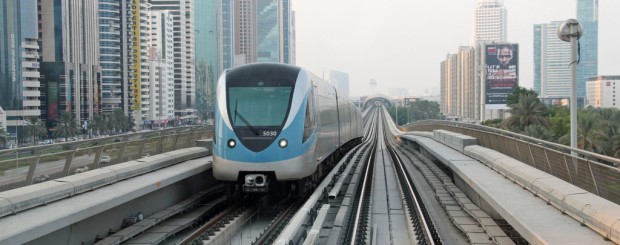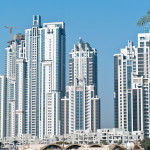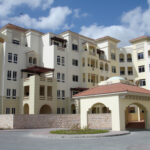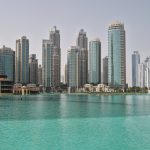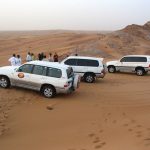Dubai Metro Explained Simply For First Time Expats and Tourists
Dubai’s Metro (light railway system) began operations on September 9, 2009, at nine minutes past nine in the evening – in numbers, at 9.9.09 at 9:09pm.
Designed to relieve pressure on Dubai’s road network, the system, which is mostly elevated (apart from a small underground section in central old town Dubai), now features forty-nine stations and almost eighty kilometers of track covering most key locations from the northern to the southern ends of Dubai.
Who can use it?
Everyone can: residents, visitors, tourists, Emirati nationals, workers, and executives. In fact, from time to time, the Crown Prince of Dubai himself, H.H. Sheikh Mohammed bin Rashid Al Maktoum, hops on board and rides a few stops to emphasize the universality of the system.
It causes quite a stir when he does this, and there’s always an entourage of minders, followers, and photographers on hand.
Obviously, at certain times in the mornings and evenings, it gets pretty crowded – and you might need to strap-hang for a couple of stops until a seat becomes available – but I’ve never seen Tokyo-type crowding on Dubai Metro trains.
Is it safe?
If you’re worried because you’ve heard there are no drivers, you’ve no need to be. The automated system is clearly the way of the future (think driverless cars), and there have been no mishaps at all in the six years of operation to date.
Trains can get up to speeds of 90kph, but mostly they operate at slower speeds, so while the system is efficient and certainly saves time, we’re not talking Bullet-Train or TGV speeds for safety margins.
The station platforms themselves have armored glass barriers between the platform edge and the tracks. Platform doors (and those on the trains) only open when the trains have come to a full stop.
Do the trains themselves attract hoards of pickpockets and other undesirables? I doubt it very much. I’ve never heard of any incidents, and a Google search for stories of the above came up with nothing.
In fact, Dubai Police maintain a pretty conspicuous presence at all Metro Stations and randomly on the trains themselves. There are also CCTV cameras installed in all cars on the trains, so a miscreant with bad intent is taking a fair old risk (given the severity of the penalties) if he or she plans to use the Metro trains as a happy hunting ground.
Is it easy and straightforward to use?
In my opinion, very. Assuming you know where you want to go, just buy a ticket to that destination at the ticket window, then hold it to the scanner at the automatic gates, pass through when they open, and proceed either up or down to your platform.
All signage is very clear, and in English as well as Arabic. At your destination, use the card again to exit the station.
If you plan to use the Metro a lot during your stay in Dubai (and it’s no surprise how the trips can mount up once you realize how very convenient the system is), then you might be advised to buy one of a number of multi-use tickets.
For new expatriates, this is the only sensible way to go. It saves you time and money. Read more about the Nol tickets and fares here.
Each train consists of five cars or coaches. Four are perfectly standard cars, but either the first or the last, depending on which direction you are travelling, are rather special. This car is divided into two sections, one being marked Gold Class – think First Class – and you need the special Gold Nol Card to ride in this section.
The other section is for women and children only, and there are penalties for being in these sections if you aren’t authorized to be there. These restrictions are very clearly marked on the outside of the coaches themselves.
What else should I know?
One thing that is probably of more use to new Dubai residents is that the operators of the Metro have provided very large free parking buildings at the first stations on the Red and Green lines – i.e. at Rashidiya Station and Etisalat Station, respectively.
There is also another very large building about half way along the Red Line at Nakheel Harbour and Tower Station. These buildings can hold between 2300 and 3000 cars.
I believe that you can leave your cars there overnight, if you prefer to taxi home, but it’s advisable to remove them fairly promptly on, say, a Friday morning, after a night on the town on Thursday.
Nol Cards have a much greater use than just the Metro – they can also be used for the Dubai Bus Network, the Dubai Creek Water Taxis (Abras), and the newly inaugurated Al Sufouh Tram.
Finally, the Metro is a very useful point of access to (or exit from) Dubai International Airport. From the Rashidiya end of the Red Line, the third and fourth stations respectively are Terminal 3 and Terminal 1.
Inexplicably, when the Metro first opened in 2009, the carrying of suitcases on Metro trains was prohibited – in fact, to do so was a fineable offence. A wiser senior official must have intervened and this was hastily amended.
So, now you can carry a standard suitcase and standard piece of cabin luggage without any problem, either from the airport to a convenient destination on the system, or vice versa.
Now in fact, so keen are the operators of the Metro to foster this connection with Dubai Airport, that three stations offer self-check-in machines to passengers travelling on Emirates Airlines, where you can choose your seat and print your boarding pass before leaving the station.
The stations offering this facility at the moment are Mall of the Emirates, Financial Centre, and Dubai Mall/Burj Khalifa.
Try it—you’ll like it!
So there it is. Six years of almost totally trouble free operation and a lot of kilometres logged up. It’s clean, it’s safe, it’s reliable, it’s convenient, and by worldly standards, it’s very cheap. Short-term visitor or newly resident expatriate, Dubai’s Metro won’t disappoint you.

